Recent Biohazard Posts
Choose Your Biohazard Cleanup Service Carefully
7/12/2018 (Permalink)
 Cleaning up blood or other bodily fluids is dangerous and requires a professional
Cleaning up blood or other bodily fluids is dangerous and requires a professional
Hazardous chemical spills and biohazards are more common than most people think. Choosing the right company to clean up a spill is critical. Here are some general guidelines that will help you choose a company that will do the job right. You’ll also find answers to many of the most frequently asked questions SERVPRO of Bloomfield/Enfield receives about biohazard cleanup.
Choose a Trained Professional
Many biohazard cleanups are required after someone has died in an accident or in a violent way. No one should have to deal with the personal impact of cleaning up after the traumatic loss of a loved one. The professionals at SERVPRO of Bloomfield/Enfield can get a traumatic event scene cleaned up quickly, compassionately, and discreetly.
Another reason to choose a trained professional is safety. United States government regulations classify all human and animal remains (including blood, urine, feces, vomit, and bodily fluids) as biohazards because they have the potential of carrying life-threatening pathogens.
Those pathogens can include Hepatitis B and C, AIDS, HIV, MRSA, tuberculosis and many more. The safe cleanup and removal of biohazardous materials involves extensive analysis and detailed work, and the use of state-of-the-art cleaning and odor removal technologies. We have the training, experience, and equipment to do the job.
Need help with chemical exposure risk or biohazard cleanup? Call us at (860) 216-2785.
Check the Biohazard Cleanup Service’s License
If you use a licensed professional firm you can be more certain the firm will conduct safe cleanup, removal, and disposal of any and all biohazardous waste. Be certain that the biohazard cleanup service is registered and compliant with the Occupational Safety and Health Administration (OSHA) and Department of Homeland Security (FEMA) regulations. These two federal agencies oversee disasters and workplace safety.
You also want certainty that the cleanup crew coming into your home or business is bonded and insured.
Pick a Service that Will Help with Your Insurance Company
In most cases, your insurance should cover much or all of the cost of traumatic event or crime scene cleanup. You can minimize or eliminate your out-of-pocket expenses by working with licensed and bonded professionals like SERVPRO of Bloomfield/Enfield. We will deal directly with your insurance companies. That will save you time and headaches.
Frequently Asked Questions (FAQ)
- Can I use my regular cleaning or janitorial service for biohazard cleanup of blood or bodily fluids?
A: Not unless your regular cleaning or janitorial service has been properly trained and equipped to handle biohazard cleanup and waste such as blood or bodily fluids, and also has a legal place to dispose of the recovered biohazardous waste.
Need help with chemical exposure risk or biohazard cleanup? Call us at (860) 216-2785.
Q: Who pays for biohazard services?
A: In many cases home, business, or auto insurance will pay. Ultimately the property owner may be responsible for cost of the service.
Q: Can I have an employee of my business clean the scene?
A: Federal Regulation 29cfr1910.1030 states that no employee can be placed in a position to be exposed to biohazard cleanup of blood spills without first:
- Receiving Blood Borne Pathogen (bbp) training
- Having a written BBP exposure control plan
- Having been provided personal protective equipment
- Having been offered Hepatitis B vaccine and exposure evaluation and follow-up
- Being provided with a method to remove and properly store the bio-hazardous waste in properly marked containers for disposal at an approved site
More Information On Our Blog
You can learn more about hazardous waste, chemical exposure, and biohazards by reading other posts on this blog:
Biohazard Cleanup
SERVPRO of Bloomfield/Enfield
Top 50 Franchise Nationally
100 Peters Road, Bloomfield, CT 06002
IICRC Certified
Noemi Garcia
Certified SERVPRO technician
Call 860.216.2785
24-hour emergency service
Asbestos Removal Questions Answered
12/20/2017 (Permalink)
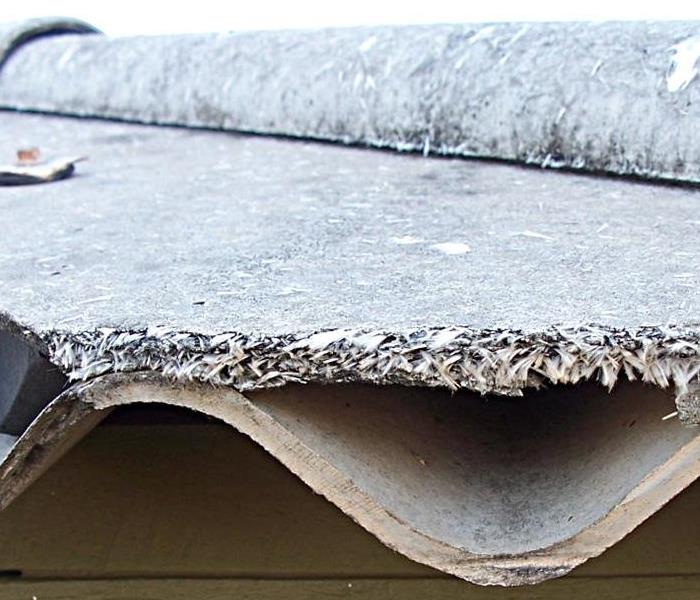 Don't try to remove asbestos on your own. Call in a professional.
Don't try to remove asbestos on your own. Call in a professional.
Asbestos Removal Questions Answered
Q: What is asbestos?
A: Asbestos is a carcinogen used extensively in building materials prior to the 1970s. It’s commonly found as duct and pipe insulation, vermiculite attic insulation*, ceiling and wall acoustical tiles, cement asbestos siding, floor tiles, floor tile adhesives, and automobile clutches and brakes.
*Vermiculite insulation is distinct from other common blown in insulation and easily spotted. Vermiculite insulation appears as gray-silvery chips about the size of a pinky nail.
Q: If I have asbestos in my home do I have to have it removed?
No. If the asbestos-containing materials in your home are undamaged, leave them alone. It’s more dangerous to disturb them, says the Environmental Protection Agency (EPA). But in most states, you must disclose the presence of asbestos to buyers of your home.
If you do remodeling and asbestos-containing materials are disrupted, the best thing to do is to have them removed professionally. Or if a storm or other natural disaster exposes asbestos you should have it removed. Removal is complex. Hire a trained and accredited asbestos professional. Improper removal may actually increase your and your family’s exposure to asbestos fibers.
Call SERVPRO Of Bloomfield/Enfield for Cleanup and Restoration. Call (860) 216-2785.
Q: What are the greatest health risks if I’m exposed to asbestos?
A: Exposure to asbestos increases your risk of developing lung disease. That risk is greater if you smoke. Disease symptoms may take many years to develop following exposure and asbestos-related conditions can be difficult to identify. Three of the major health effects associated with asbestos exposure are lung cancer, mesothelioma, and asbestosis (a serious progressive, long-term, non-cancer disease of the lungs).
Q: Can asbestos be removed while people continue to work or live on the property?
A: Yes, but those workers will probably have to be relocated to another part of the building temporarily. And the part of the building where asbestos is being removed must be sealed off. This prevents contamination of the other areas.
Q: How do you seal off an area during asbestos removal?
A: Methods of sealing off an area include using polyethylene film, duct tape, and negative air pressure machines fitted with HEPA filters. When properly applied, the film and duct tape don’t allow air-borne asbestos fibers to travel to other parts of the home or building. The negative air pressure machine pulls fresh air into the asbestos area while not allowing any asbestos fibers out into the surrounding environment.
Call SERVPRO Of Bloomfield/Enfield for Cleanup and Restoration. Call (860) 216-2785.
Q: Can a regular vacuum cleaner be used to remove asbestos?
A: No. Only a special vacuum cleaner designed for asbestos containment (class H) can be safely used when cleaning up during and after asbestos removal. Even an ordinary vacuum cleaner fitted with a HEPA filter is not safe. That ordinary vacuum cleaner will expel the asbestos fibers into the room air.
Q: What does it cost to remove asbestos from a house?
Asbestos removal costs vary depending on how much work must be done. Some contractors have a minimum fee of $1,500 to $3,000. Complete removal in a 1,500-square-foot home with asbestos everywhere—walls, floors, ceilings, attic, roof, pipes—could be as high as $20,000 to $30,000. But that’s unusual.
Q: Where can I go for more information?
The federal government’s Environmental Protection Agency has lots of information on asbestos and how to protect your family.
Help Is Here
The team at SERVPRO of Bloomfield/Enfield also has specialized training and experience in fire restoration services, natural disaster prevention, water damage, chemical cleanup, and natural disaster cleanup. Call SERVPRO of Bloomfield/Enfield (860.216.2785) anytime.
SERVPRO of Bloomfield/Enfield
Top 50 Franchise Nationally
100 Peters Road, Bloomfield, CT 06002
IICRC Certified
Noemi Garcia
Franchise Owner
Call 860.216.2785 24 hour emergency service
Preventing Carbon Monoxide Poisoning
12/1/2016 (Permalink)
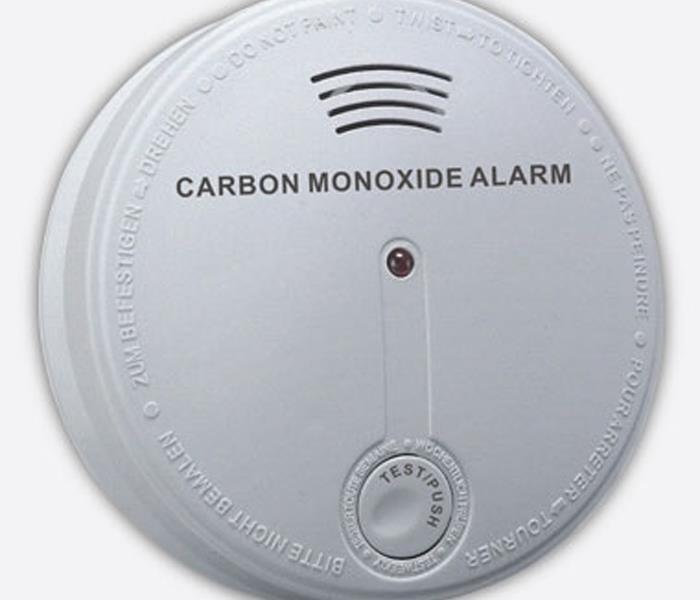 Have carbon monoxide (CO) detectors installed on each level of your home and business.
Have carbon monoxide (CO) detectors installed on each level of your home and business.
Lose power during an emergency and you’ll be grateful if you have a portable generator for electricity. You might also use an outdoor grill for cooking. But the Connecticut Department of Public Health cautions everyone to use generators and grills with care. Here are some guidelines from the department’s Connecticut Guide to Emergency Preparedness.
Avoid CO Build Up
Misuse of portable generators and outdoor grills or other cooking devises can cause carbon monoxide (CO) to build up in your home, garage, camper, or other confined space. CO can poison animals and people. Follow these guidelines:
1. Don’t use a portable generator inside your home, garage, carport, basement, covered porch, or any enclosed space.
2. Use a generator outside at least 20 feet from your own and any neighbors’ homes or businesses. Keep the portable generator away from doors, windows, and air intake vents so the CO it generates will not be able to travel inside.
3. Propane and kerosene heaters can also help in an emergency but keep them outside.
Whatever your natural disaster question is, SERVPRO of Bloomfield/Enfield has answers. Call at 860-216-2785.
4. You may be tempted to use your gas oven or stove top to heat your house. Never do that.
5. Before an emergency check to make sure you have CO detectors installed on each level of your home and business. Have them right outside sleeping areas, too. Change the batteries every six months and replace your CO detector every five years.
6. Know that opening windows and doors and using fans is not enough to stop a deadly buildup of carbon monoxide in your home or business.
CO Poisoning Can Look Like The Flu
7. The symptoms of CO poisoning are similar to flu symptoms: headache, tiredness, dizziness, nausea, vomiting, or loss of consciousness. These signs may be your only warning because you cannot see or smell CO.
8. If you have the symptoms of CO poisoning or if someone around you does, go outside to get in the fresh air. Dial 9-1-1 from a mobile phone or from a neighbor’s house. If you’re in Connecticut you should also call the Connecticut Poison Control Center at 1-800-222-1222.
CO or natural disaster questions? Call SERVPRO of Bloomfield/Enfield at 860-216-2785.
9. After a snow storm, make sure your car's exhaust pipe is clear. A clogged exhaust pipe could lead to carbon monoxide buildup in your vehicle.
10. There’s more information about carbon monoxide on the Connecticut Department of Public Health CO Poisoning page.
A Wealth Of Natural Disaster Information For You
Every month on our blog, SERVPRO of Bloomfield/Enfield publishes educational articles on how to prevent natural disasters and deal with them quickly and effectively should they occur.
SERVPRO Excels
Many factors make SERVPRO of Bloomfield/Enfield a great choice for restoration after a natural disaster or for disaster cleanup:
• More than 40 years of experience as a leading fire and water cleanup and restoration provider
• A network of 1,500 franchises nationwide so we can call in any resource you might need
• On site evaluation of your natural disaster recovery needs within four hours of you contacting SERVPRO of Bloomfield/Enfield (860-216-2785)
• Highly trained staff with experience in all types of natural disasters
• Assistance with dealing with your insurer and filing a claim
• Local knowledge and resources—we know your community and we have relationships with other local organizations that can help you in times of need
Here To Help You
The team at SERVPRO of Bloomfield/Enfield also has specialized training and experience in water damage restoration services, fire damage restoration services, mold remediation, commercial restoration, commercial cleanup, and natural disaster cleanup. Call SERVPRO of Bloomfield/Enfield (860-216-2785) any time, any day of the year.
We've served clients in Avon, Agawam, Bloomfield, Coventry, East Hartford, East Longmeadow, Ellington, Enfield, Farmington, Hartford, Manchester, Newington, Simsbury, South Windsor, Springfield, West Hartford, and beyond.
SERVPRO of Bloomfield/Enfield
100 Peters Road
Bloomfield, Connecticut
IICRC Certified
Noemi Garcia
Franchise Owner
Call 860-216-2785 anytime
Hazardous Chemical Exposure
9/6/2016 (Permalink)
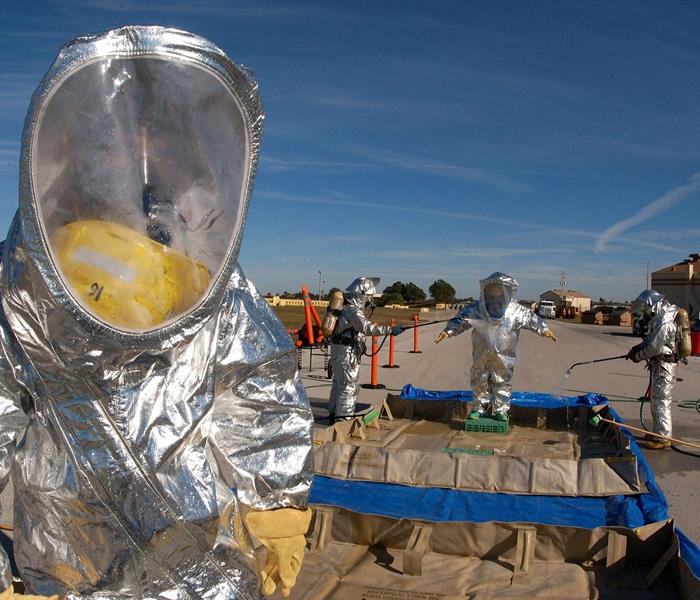 Workers suffer more than 190,000 illnesses and 50,000 deaths annually related to chemical exposures.
Workers suffer more than 190,000 illnesses and 50,000 deaths annually related to chemical exposures.
According to OSHA, workers suffer more than 190,000 illnesses and 50,000 deaths annually related to chemical exposures. Workplace chemical exposures have been linked to cancers and other lung, kidney, skin, heart, stomach, brain, nerve, and reproductive diseases. There are four major ways you can control exposure to hazardous chemicals:
1. Eliminate or substitute for the dangerous chemical.
2. Install physical controls to access to the chemical.
3. Implement administration and business practice controls.
4. Use protective equipment.
The easiest and quickest way of controlling exposure to hazardous chemicals may be to stop using the hazardous chemical or start using another safer chemical in place of the dangerous chemical. Transitioning to safer alternatives can be a complex undertaking, but a variety of existing resources make it easier. OSHA has developed a step-by-step toolkit to provide employers and workers with information, methods, tools, and guidance on using informed substitution in the workplace.
Need help assessing your chemical exposure risks? Call us at (860) 216-2785.
A second way to control hazardous chemical exposure is to implement a physical change in the workplace that reduces or eliminates the hazard. Examples are changing a process so it minimized the contact workers have with the hazardous chemicals and isolating or enclosing the process. Other companies have switched to a wet method of using a hazardous chemical to reduce the dust or particulates working with the chemical produces. Fume hoods and improved ventilation can be solutions in other situations.
Changing Practices or Controls
A third alternative is to change the work practice or administrative controls. That could mean rotating job assignments or adjusting work schedules so that your workers are not overexposed to a hazardous chemical.
Using Protective Equipment
A fourth way to control exposure to hazardous chemicals is to use chemical protective clothing like eye protection and gloves. OSHA says an estimated 5 million workers are required to wear respirators in 1.3 million workplaces throughout the United States. Respirators protect workers against insufficient oxygen environments, harmful dusts, fogs, smokes, mists, gases, vapors, and sprays.
OSHA can help answer questions or concerns from employers and workers. To reach your regional or area OSHA office, go to the OSHA Offices by State webpage or call 1-800-321-OSHA (6742). Small businesses may contact OSHA's free On-site Consultation services funded by OSHA to help determine whether there are hazards at their worksites. To contact free consultation services, go to OSHA's On-site Consultation webpage or call 1-800-321-OSHA (6742) and press number 4.
We Can Help
The team at SERVPRO of Bloomfield/Enfield has specialized training and experience in fire restoration services, natural disaster prevention, natural disaster cleanup, and controlling exposure to hazardous chemicals. Our expertise also includes electronics restoration and document drying. And we’re your business’s best resource for mold mitigation and removal. Call SERVPRO of Bloomfield/Enfield (860.216.2785) anytime, 24/7.
We've served clients in Avon, Agawam, Bloomfield, Coventry, East Hartford, East Longmeadow, Ellington, Enfield, Farmington, Hartford, Manchester, Newington, Simsbury, South Windsor, Springfield, West Hartford, and beyond.
SERVPRO of Bloomfield/Enfield
100 Peters Road, Bloomfield, CT 06002
IICRC Certified
Noemi Garcia
Franchise Owner
Call 860.216.2785
24 hour emergency service
Chemical Caution: What To Know Before You Enter That Damaged Home Or Business
2/25/2016 (Permalink)
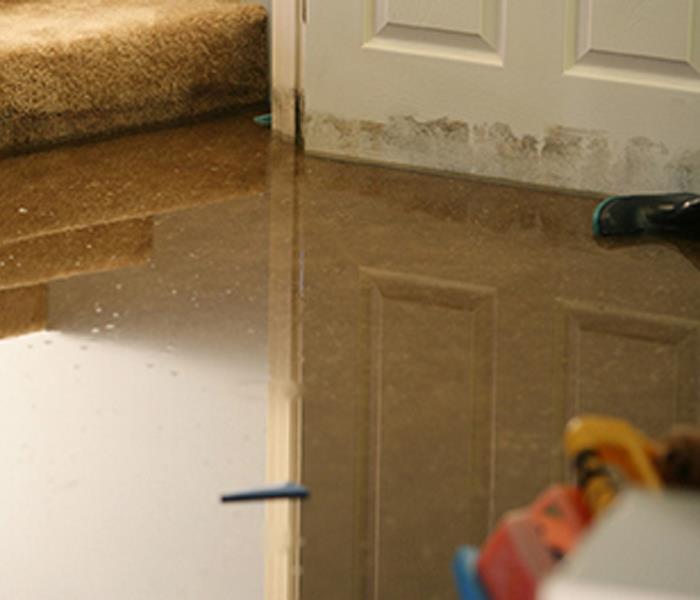 Enter a damaged business or home with caution. Don't take risks.
Enter a damaged business or home with caution. Don't take risks.
After a natural disaster the local authorities often ban residents and businesses from re-entering buildings until emergency crews have completed their work and the buildings are considered safe.
But even when the authorities give the okay to return to your home or your business the Environmental Protection Agency advises you to take precautions like:
• Be on the alert for leaking containers, especially of chemicals like caustic drain cleaners and chloride bleach.
• Keep people and pets away from leaking or spilled chemicals.
• Avoid contact with flood water. Often, flood water is contaminated with raw sewage or hazardous chemicals.
For Expert Disaster Advice Call SERVPRO of Bloomfield/Enfield At (860) 216-2785
• Do not combine chemicals from leaking or damaged containers as this may produce dangerous or violent reactions.
• Don’t dump chemicals down drains, storm sewers, or toilets.
• If you have any doubts about your safety, call SERVPRO of Bloomfield/Enfield.
• Never attempt to burn household or business chemicals.
• Clearly mark and set aside unbroken containers until they can be properly disposed of.
• Leave damaged or unlabeled chemical containers undisturbed whenever possible.
• Don’t turn on drinking water pumps (risk of electric shock) or use the septic system until you have it inspected.
• Open all the windows.
What If You Smell Gas?
If you smell gas or hear the sound of escaping gas, don't smoke, light matches, or operate electrical switches. Don't use either cell or conventional telephones or create any other source of ignition. Leave the building immediately. Leave the door open and any windows that may already be open. Notify emergency authorities. Don't return to the building until you are told by authorities that it is safe to do so.
Stay Away from Building Materials
Avoid walking over or otherwise disturbing building materials. Building materials may contain hazardous chemicals or components such as asbestos. These materials, when carried by the air, can be breathed in and cause adverse health effects. Staying away can prevent physical injury and other health issues. If you suspect that asbestos containing materials may be present in your building or home, do not enter.
Possible Asbestos Materials
Asbestos-containing materials often include the following:
• Boiler/pipe insulation
• Fireproofing
• Floor tiles
• Asbestos roofing
• Transite boards used in laboratory tabletops and in acoustics in auditoriums, music rooms and phone booths
Federal, state, and local personnel are often deployed to affected areas to establish debris-management programs, including household hazardous waste collection and disposal programs. These efforts may take days or weeks to come to all communities. In the meantime, EPA urges the public to exercise caution and report concerns to local environmental, health and waste disposal authorities.
We’re Here To Help
The team at SERVPRO of Bloomfield/Enfield has specialized training and experience in virtually all aspects of assessing and cleaning up after a natural disaster. Rely on the professionals. Call SERVPRO of Bloomfield/Enfield (860.216.2785) anytime, 24/7.
SERVPRO of Bloomfield/Enfield
100 Peters Road, Bloomfield, CT 06002
IICRC Certified
Noemi Garcia
Franchise Owner
Call (860) 216-2785
24 hour emergency service
Chemical Emergencies: Preventing and Handling Them
10/5/2015 (Permalink)
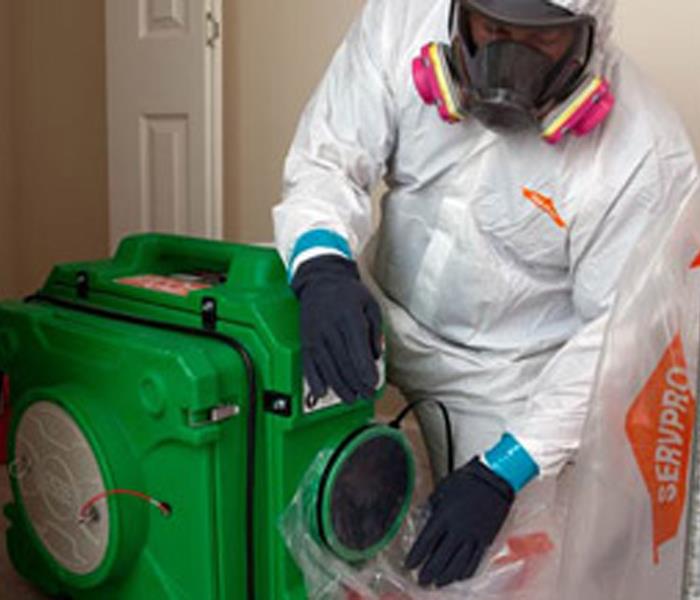 If the emergency is a chemical spill inside your commercial building or home, clean it up immediately.
If the emergency is a chemical spill inside your commercial building or home, clean it up immediately.
Chemical emergencies can happen when gasses, liquids, or solid materials that can poison people have been released. Some chemicals are very dangerous and can make you sick right away. Others are less dangerous. In general, chemicals in liquid or gas form are more dangerous than solids. Some keys to preventing and being prepared for a chemical emergency are:
1. Have an emergency supply kit ready.
2. Know which room or area is best for you to go to in an emergency and make sure everyone who uses your building knows where that area is. Often, a good choice is a room in the middle of your business, building, or home that lacks windows and is high above ground level.
Need Chemical Emergency Cleanup Services? Call Us Today – (860) 216-2785
3. Take a tour of your business or home to see where chemicals are located. Check the label and take the necessary steps to ensure that you are using, storing, and disposing of each chemical according to the manufacturer’s directions. Keep products containing hazardous materials in their original containers. Never remove the labels unless the container is corroding. Repackage corroding containers and clearly labeled them. Don’t store chemicals or other hazardous products in food containers.
4. At home, store household chemicals in places where children cannot gain access them. Locked cabinets is one good choice. Products such as aerosol cans of hair spray and deodorant, nail polish and nail polish remover, toilet bowl cleaners, and furniture polishes all fall into the category of hazardous materials.
5. Never mix household hazardous chemicals or waste with other products. Incompatibles (such as chlorine bleach and ammonia) may react, ignite, or explode.
When A Chemical Emergency Happens
• Close all your doors and windows.
• If there’s a fireplace, close the damper.
• Turn off fans, air conditioners, and forced-air heating units that bring in fresh air from the outside.
• If you’re told to stay where you are, move to an inside room and bring your emergency supply kit. Check local TV and radio stations or the Internet for official news, information, and instructions.
• Consider whether you should seal the room (see below).
• If the emergency is a chemical spill inside your commercial building or home, clean it up immediately. Use rags and wear gloves and eye protection. Allow the fumes in the rags to evaporate outdoors, then dispose of the rags by wrapping them in a newspaper and placing them in a sealed plastic bag in your trash can.
• Learn to recognize the symptoms of toxic poisoning: difficulty breathing; irritation of the eyes, skin, throat, or respiratory tract; changes in skin color; headache or blurred vision; dizziness; clumsiness or lack of coordination; cramps; or diarrhea.
• Be prepared to seek medical assistance. Post the number of the emergency medical services and the poison control center by all telephones. The national poison control number is (800)-222-1222.
Sealing A Room
During a chemical, nuclear, or radiological emergency, the air outside may be dangerous. For short periods of time sealing the room can help protect you from harmful outside air. If you see large amounts of debris in the air, or if local officials say the air is dangerous, you may want to take this kind of action.
Use duct tape and plastic sheeting to seal any doors, windows, or vents. Within two to three hours you should take down the plastic and duct tape and air out the room. You can suffocate if you keep the room tightly sealed for more than five hours.
The plastic sheeting should be 2-4 millimeters thick. Cut the plastic sheeting at least six inches wider than the openings. You may want to do this in advance to save time. Duct tape plastic at the corners first and then tape down the edges.
Please refer to our Biohazard Emergency Cleanup Tips - Until Help Arrives Guide and follow the tips to protect yourself and your property.
We’re here to help. The team at SERVPRO® of Bloomfield/Enfield has specialized in handling chemical emergencies. We have the training and experience to quickly clean up and restore your commercial building or property. Call SERVPRO of Bloomfield/Enfield (860.216.2785) anytime, 24/7.
We've served clients in Ellington, West Hartford, Avon, Springfield, Manchester, Hartford, Newington, Bloomfield, East Hartford, Enfield, Simsbury, Farmington, Coventry, South Windsor, Agawam, and beyond.
SERVPRO of Bloomfield/Enfield
100 Peters Road, Bloomfield, CT 06002
IICRC Certified
Noemi Garcia
Franchise Owner
Call (860) 216-2785
24 hour emergency service
Biohazard Cleanup
6/25/2015 (Permalink)
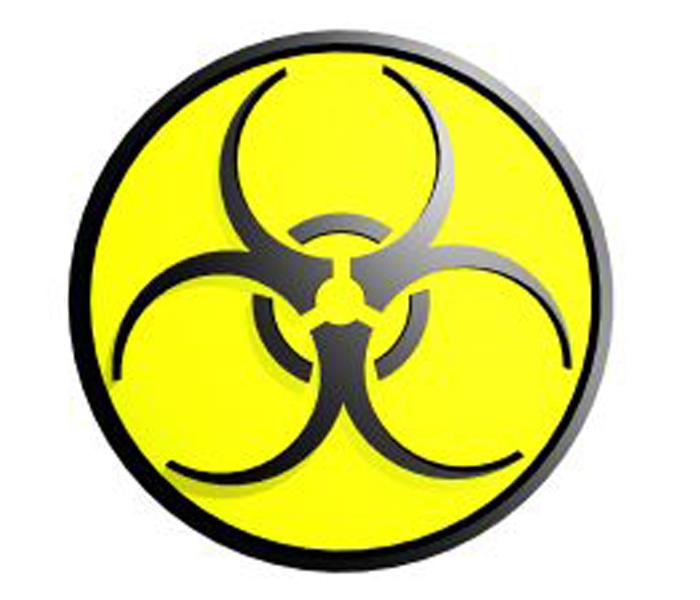 Biohazard contaminants are dangerous. They can pose serious health risks. This biohazard symbol was developed by the Dow Chemical Company in 1966.
Biohazard contaminants are dangerous. They can pose serious health risks. This biohazard symbol was developed by the Dow Chemical Company in 1966.
Many people don’t realize how common biohazards are. It sounds like something that may only happen at old industrial sites or where people are not sensitive to the environment. But this is a misperception. Biohazards include fairly frequent occurrences like sewer backups and flood water damage. Biohazards affect tens of thousands of homes and businesses every year.
Need Biohazard Cleanup? Call Us Today – (860) 216-2785
For your health and safety, consider biohazard contaminants very dangerous. SERVPRO® of Bloomfield/Enfield has the training, protective gear, and specialized equipment necessary to safely clean and restore biohazard contamination.
Be Safe After A Biohazard Contamination
After a sewer backup, flood water damage, or other biohazard contamination, think about whether it’s safe to return to your house or business. Being exposed to biological or chemical contaminants can pose serious health risks. Flood waters usually contain biohazards like pesticides, sewage, and other contaminants. If you’re not certain your activity is safe to perform do not take the risk.
What To Do After A Biohazard Contamination
• Stay out of affected areas.
• Call emergency service personnel if the situation may be life-threatening.
• Treat all bodily fluids as if they are contaminated.
• Turn off the HVAC system if there is sewage damage.
What Not to Do After a Biohazard Contamination
• Don’t leave wet fabrics in place. Hang furs and leather goods.
• Don’t leave books, magazines, or other colored items on wet carpets or floors.
• Don’t use your household vacuum to remove water.
• Don’t use your television or other household appliances.
• Don’t turn on ceiling fixtures if ceiling is wet.
• Stay out of rooms where ceilings are sagging.
Call SERVPRO of Bloomfield/Enfield anytime, 24/7 at 860.216.2785. SERVPRO’s carpet cleaners service is among the best cleaning services. We’re trained in the most advanced, thorough, and effective ways to perform biohazard cleanups. We've served clients in Ellington, West Hartford, Avon, Springfield, Manchester, Hartford, Newington, Bloomfield, East Hartford, and beyond.
SERVPRO of Bloomfield/Enfield
100 Peters Road, Bloomfield, CT 06002
IICRC Certified
Noemi Garcia
Franchise Owner
Call (860) 216-2785
24 hour emergency service






 24/7 Emergency Service
24/7 Emergency Service





